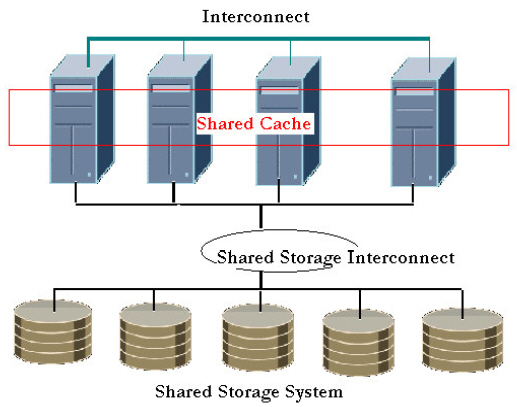[March 10, 2010 Update: OCFS2 for Linux is now certified for EBS 12 application tier servers; see this article for details.]
Hmmm. Let’s see how many cryptic acronyms we can stuff into a six-word title… There’s been a flurry of Oracle Cluster File System-related queries this week; must have something to do with the impending Autumnal equinox.
When you deploy Real Application Clusters (RAC) in your Apps environment, you deploy a cluster of database servers that access datafiles on a shared storage system, like this:

Oracle has two technologies that support this:
- Oracle Cluster File System (OCFS)
- Automatic Storage Management (ASM)
Oracle Cluster File System or Automatic Storage Management?
Given the choice between using OCFS2 or ASM, the Applications Technology Group strongly recommends the use of Automatic Storage Management for E-Business Suite database servers. E-Business Suite Release 11i is formally certified with Automatic Storage Management. For an in-depth discussion of what “E-Business Suite certification” really means, see:
Supported for use with Apps Database Servers Only
Due to our focus on Release 12 and Fusion, the Applications Technology Group does not plan to perform formal certification of the E-Business Suite Release 11i with OCFS2. The underlying OCFS2 technology has been certified for use with Oracle databases and Real Application Clusters. So, it should work transparently with E-Business Suite databases, too.
The Applications Technology Group will support the use of OCFS2 for the
E-Business Suite 11i database tier but not the application server tier.
OCFS2 is certified with a specific set of RAC versions, so Apps customers interested in using this technology must check the OCFS2 documentation to ensure that their desired Oracle database and Linux combinations are certified together.
What Does “Support” Mean?
As is the usual case for these types of “supported but not certified” configurations, you should thoroughly test OCFS2-based E-Business Suite RAC environments prior to production rollouts.
If you report any issues with this configuration, Oracle will attempt to issue a fix or workaround for OCFS2 or the E-Business Suite. This may not be technically feasible in all cases. If it isn’t technically feasible, the Applications Technology Group may recommend that you convert your E-Business Suite RAC implementations to use Automatic Storage Management instead.
Related
- Using RAC & ASM with E-Business Suite Databases
- Cheatsheet: Supported Database Configurations with Apps 11i
- RAC Frequently Asked Questions (Metalink Note 220970.1)
- OCFS2 Frequently Asked Questions (Metalink Note 391771.1)
